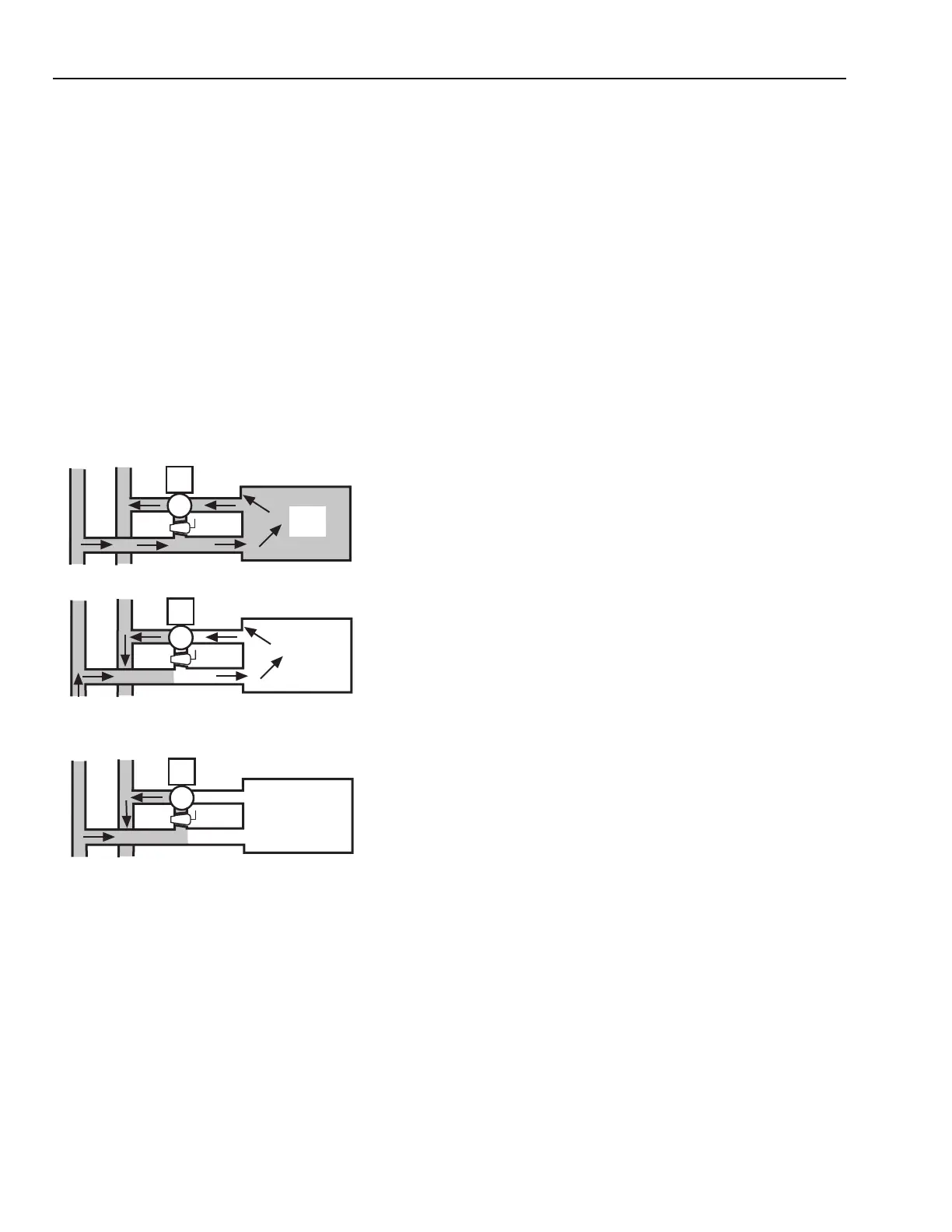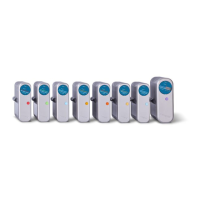ENGINEERING MANUAL OF AUTOMATIC CONTROL
CHILLER, BOILER, AND DISTRIBUTION SYSTEM CONTROL APPLICATIONS
348
METHODS OF CONTROLLING
DISTRIBUTION SYSTEMS
There are several methods for controlling pressure and flow in
water distribution systems. The methods described in this section
apply, in general, to both heating and cooling applications.
THREE-WAY COIL BYPASS AND
TWO-WAY VALVE CONTROL
Coil bypass control uses three-way valves on terminal units
and other coil loads in a water distribution system and satisfies
the first four of the control system requirements (see CONTROL
REQUIREMENTS FOR WATER DISTRIBUTION
SYSTEMS). At reduced loads, the flow bypasses the coils and
goes directly to the return main. Figure 72 illustrates the
operation of this system as requirements change. Balancing
valve (B) is adjusted for equal flow in the coil and the bypass
— Piping Cost. Costs are higher for three-way valves than
two-way valves, especially where limited space is
available for piping (such as in room air conditioning
units and unit ventilators). In addition, balancing cocks
must be installed and adjusted in the bypass line.
— Three-Way Valve Cost. A diverting valve is more
expensive than a mixing valve and a mixing valve is more
expensive than a two-way valve. A mixing valve installed
in the leaving water from a coil provides the same control
as a diverting valve installed on the inlet to the coil.
— Diversity. If chillers and pumps are selected based upon
diversity, three-way valves are inappropriate.
— Flow Characteristics. Three-way valves have linear
flow characteristics and two-way valves may be either
linear or equal percentage. Obtaining close control with
three-way valves requires use of scheduled (reset) hot
water temperatures.
— Capacity Index (K
V
). Three-way valves for K
V
s below
1.0 are often not available, therefore, small three-way
valves tend to be oversized. Consider using two-way
control valves for all applications of K
V
= 4.0 and less
where the quantity of two-way valves will have little
effect on the total system flow.
— Constant Flow in Mains. Constant flow provides nearly
constant pressure differential (drop) across a coil and valve.
— Pumping Cost. A three-way valve system uses full pump
capacity even when the system load is very small.
— Part Load Control. Two-way valves allow better control
on multiple pump systems during pump failure or part
load periods.
— Automatic Control. Distribution control is a manual
balancing task for flow loops employing three-way
control valves. Automatic distribution controls are
usually required to maintain flows and pressures (bypass
valve, variable speed pump, pump staging control) for
flow loops employing two-way control valves.
For further discussion on control valves, refer to the Valve
Selection and Sizing section.
FLOW AND PRESSURE CONTROL SOLUTIONS
Control solutions for water distribution systems may vary
based on:
– Direct return vs reverse return piping
– Pressure bypass valve control vs variable speed
pumping systems
– Coupled secondary systems vs decoupled systems
– Evenly varying heating/cooling loads vs unevenly
varying loads
– Variable flow vs constant flow systems
– Single pump vs multiple parallel pump systems
– Pressure bypass valve objectives of maintaining high
flow rates through chillers vs maintaining a low drop
across control valves
Fig. 72. Three-Way Valve Control—Coil Bypass.
Two way valves vary both the coil flow and the system flow,
thus using less pumping energy at reduced flow.
VALVE SELECTION FACTORS
Consider the following factors when deciding on two-way
or three-way control valves.
1 L/s
FULL
HEATING
(OR COOLING)
COIL
1 L/s
MODULATED
HEATING
(OR COOLING)
O L/s
0.5 L/s
NO FLOW
THRU COIL
NO HEATING
(OR COOLING)
COIL
0.5
L/s
0.5 L/s
1 L/s
0 L/s
1 L/s
1 L/s
SUPPLY
MAIN
RETURN
MAIN
C4605
3 WAY VALVE
B
B
B

